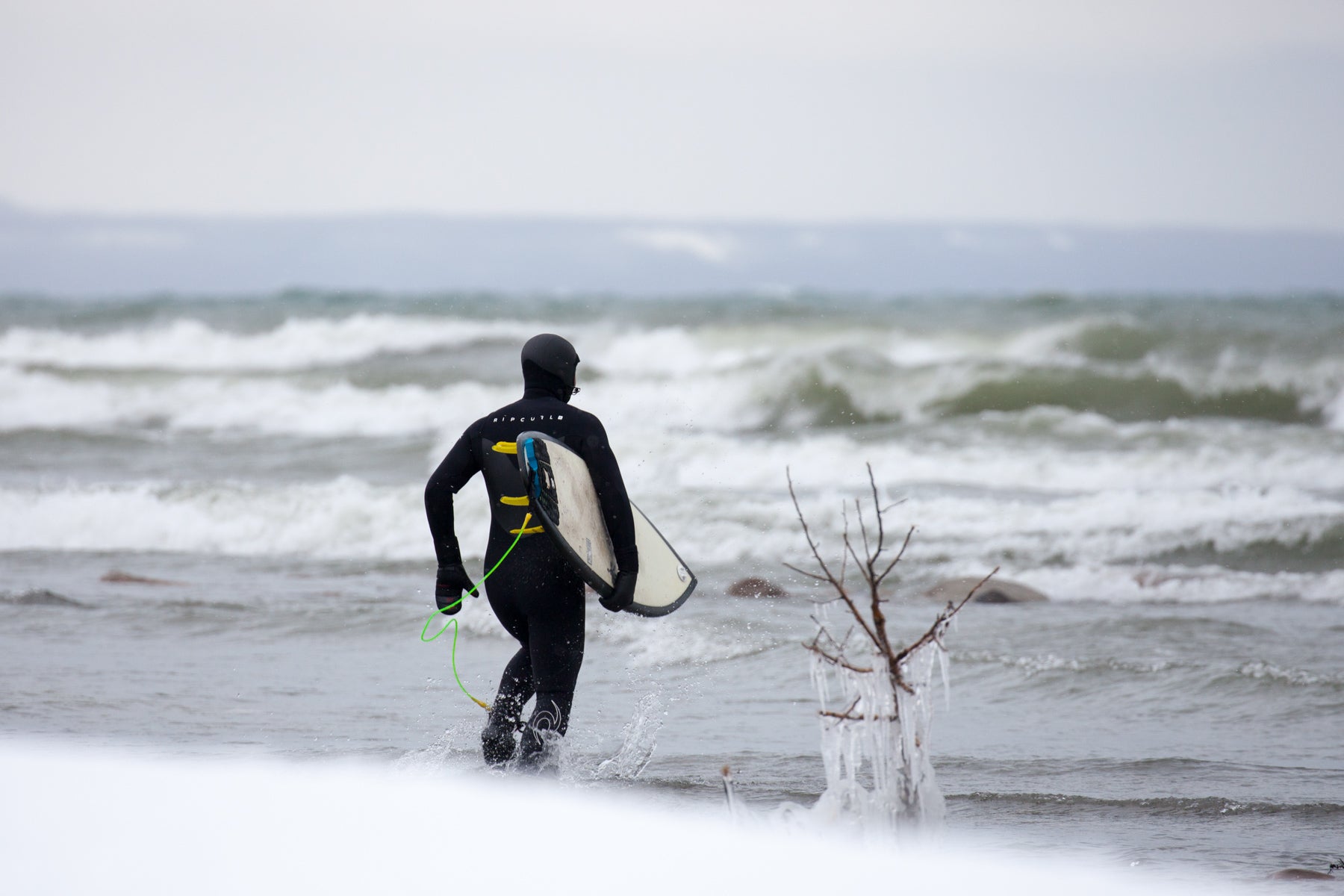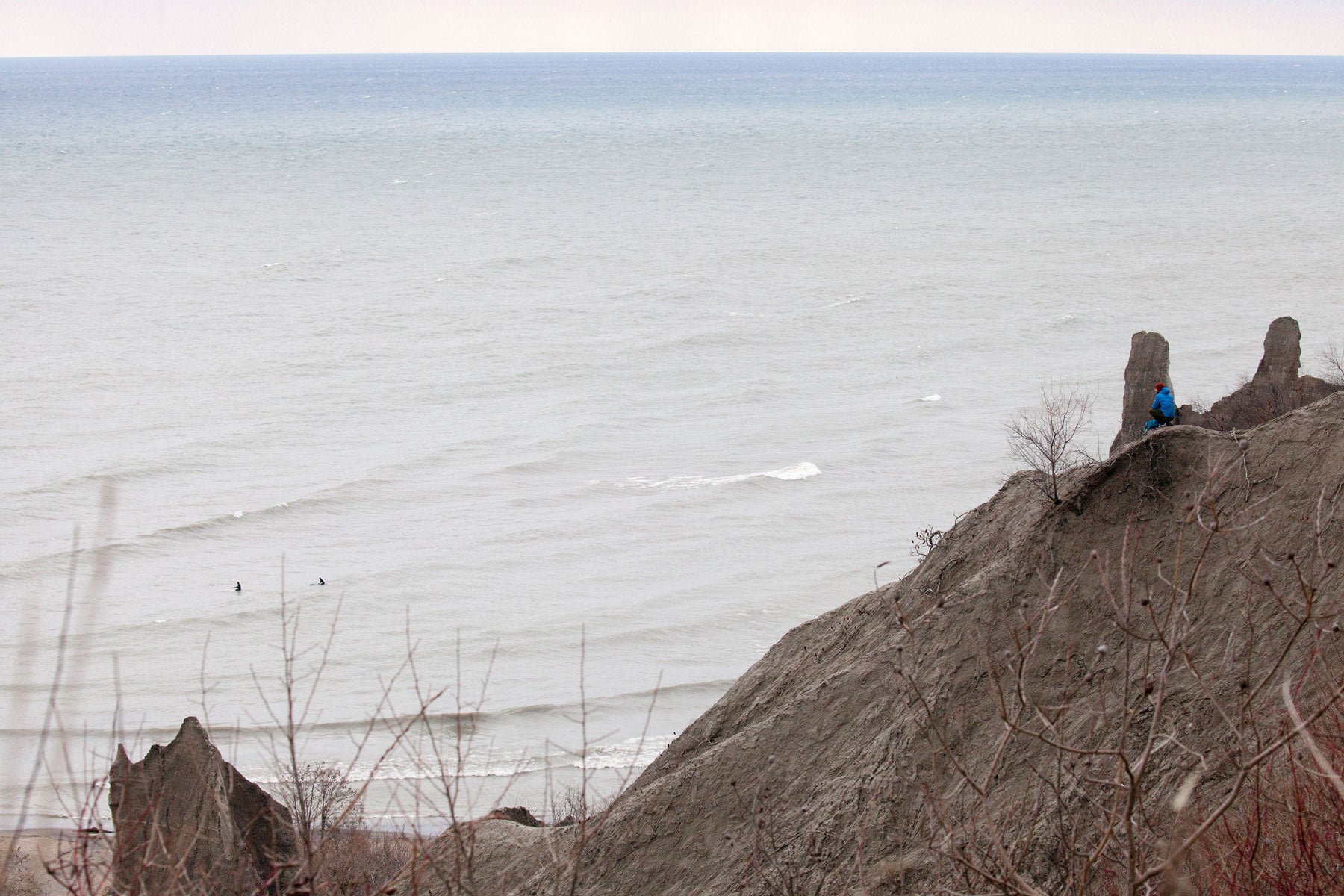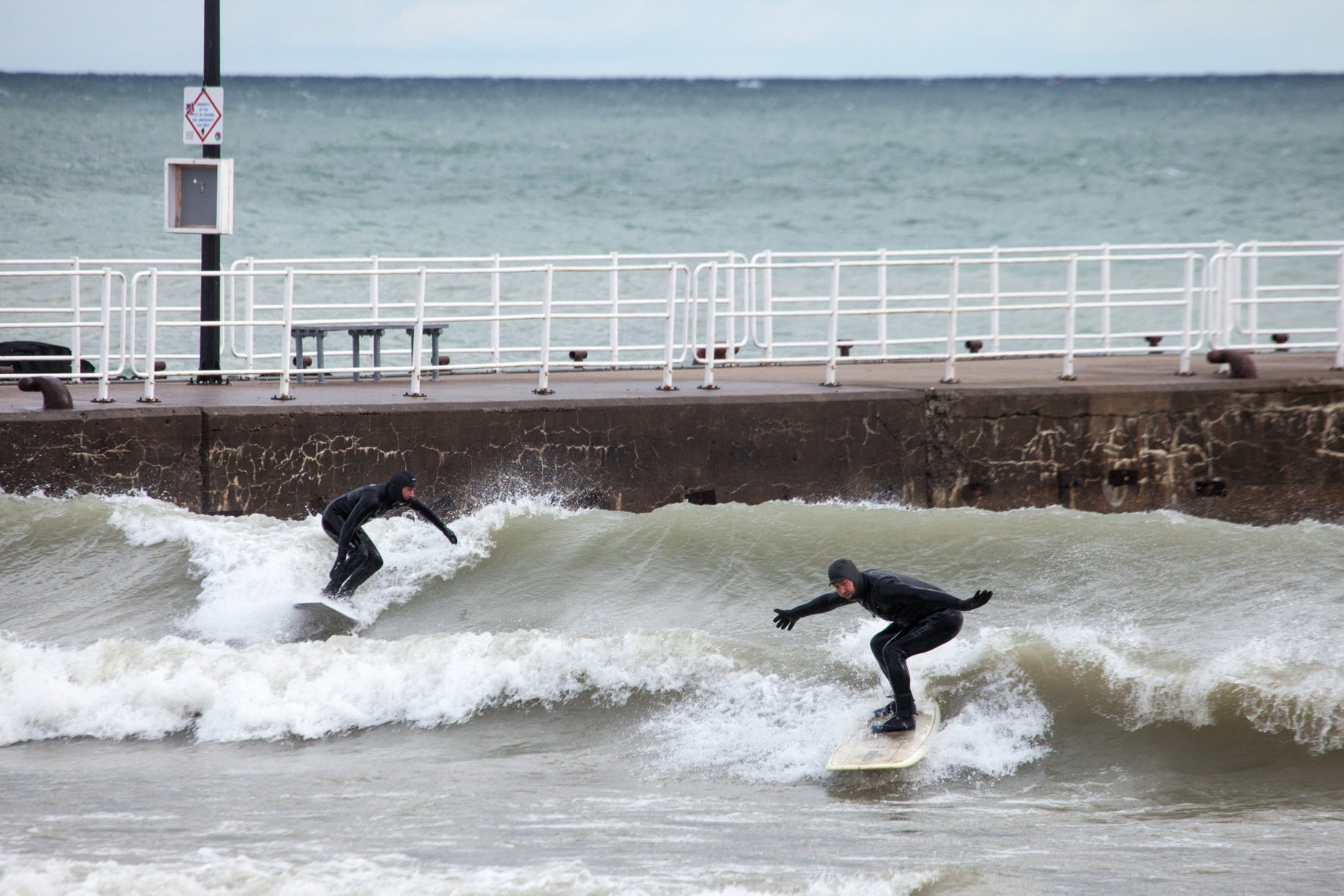Lake Surf 101
SURFING THE GREATS
Surfing the Great Lakes is a blast. While it’s not ocean surfing, it’s got its own set of challenges and rewards created by wind, weather and season. This FAQ will get you started, keep you safe and help you make the most of surfing in Canada’s freshwater playgrounds.
How do you surf the Great Lakes?
You can surf the Great Lakes year round thanks to wind waves. To get started you’ll need:
- The right gear: A surfboard and wetsuit for freshwater and cold water.
- Conditions knowledge: Knowing when and where waves will show up.
With a flexible schedule and access to transportation, surfers can score waves 2-3 times a week during peak season (September–April).
What is surfing and how is it different from other water sports?
Surfing means standing and riding a wave created by wind or swell as it breaks on a shallow surface. Unlike wakesurfing or windsurfing, traditional surfing involves paddling into waves and using natural forces to ride along their breaking line. While other water sports may include surfing elements, the core of surfing is the connection to the wave itself.
When can you surf the lakes?
The surf season is late summer to late spring, with the best conditions in fall and winter. Colder air is denser and interacts more with warmer water to create the perfect conditions for swell. Here’s a quick rundown:
- Fall: Prime surf season, waves are frequent and big.
- Winter: Waves for hardy surfers with cold water gear.
- Spring: Mixed conditions, cold and warm days.
- Summer: Unreliable but sometimes surfable.

What boards work on the Great Lakes?
Freshwater has less buoyancy than saltwater so foam friendly, floaty boards are recommended. Beginners start with soft-top boards for added safety and stability. Talk to a Surf the Greats team member to make sure you’re using the right gear for your size, skill level and conditions.
What wetsuit thickness do I need?
Your wetsuit is your most important piece of gear for lake surfing. Thickness depends on the season:
- Summer (June–August): 3/2 mm to 4/3 mm wetsuit.
- Fall/Winter (November–April): 5/4 mm to 6/5 mm wetsuit, boots, gloves and hood (5-7 mm).
- Spring (May): Layer down as temperatures rise.
Buying a thick suit for year round use is cost effective and ensures you’re ready for the cold months. Check out our neoprene here.
How do I know when and where to surf?
Timing and location are key to lake surfing. Here’s the basics:
- Wind Speeds: 30 km/h or more sustained for 3-4 hours will produce swell.
- Wind Directions:
- Lake Ontario (Toronto, Hamilton): NE, E, SW
- Lake Erie (East Side): SW, W
- Lake Huron (East Side): N, NW, W
- Georgian Bay (South Side): NW, N, W

Great Lakes Wave Forecasting Resources
Wave forecasting is key to a safe and fun surf session. Here are the best tools and platforms to help you plan your sessions:
Windy: Wind and wave forecasts with interactive maps. Real-time data visualization so you can see the conditions at a glance.The Weather Network: Weather forecasts for the Great Lakes region. Detailed info on atmospheric pressure (low pressure systems), wind speed, consistency, direction and air temp.
Seagull by Great Lakes Observing System (GLOS): Live data on wave heights, wind speeds and water temperatures. Allows surfers to check real-time conditions at specific locations. Buoys that provide this data are removed during winter months.
Swim Guide: Up-to-date water quality info for beaches. Helps surfers enter safe and clean water, especially after heavy rain or in polluted areas.
Great Lakes Coastal Forecasting System (GLCFS): Lake circulation, thermal structure and wave dynamics using hydrodynamic models. Nowcasts and forecasts to understand lake behaviour and conditions.
CoastWatch Great Lakes Node: Satellite data on lake conditions, surface temps and ice cover. Tracks algal blooms, plumes and other surf affecting conditions.
Use these resources to plan ahead and surf smarter. Always cross check multiple sources for the most current info.

Can I use Surfline or Magic Seaweed for forecasting waves on the lakes?
Yes, but most forecasting websites fail to account for the nuance and volatility of swell generation on the lakes, so these websites can be unreliable. Cultivating a knowledge of the unique way surf works here is your best bet for forecasting here on the lakes.
What is the water quality like in Lake Ontario?
Generally speaking, Lake Ontario’s water is clean and safe for swimming. It’s important to know that bacteria levels are highest after storms/rain. Some surfers elect to use special earplugs to protect themselves. With that being said, health issues can be an issue. We work with local not-for-profit organizations such as the Lake Ontario Waterkeeper and Swim Drink Fish on beach cleanups and other environmental initiatives to protect and preserve the Great Lakes. We advise our community to swim and surf at their own risk.

Is there a surf community on the Great Lakes?
Yes! The Great Lakes surf community is alive and kicking. Surf shops, events, contests and arts collaborations, there’s lots of ways to get involved. Join our community events and be part of this movement.
Got tips for beginners?
- Recalibrate Expectations: Lake surfing is different from ocean surfing.
- Enjoy the Experience: Snowfall surf sessions and uncrowded lineups, you won’t find this anywhere else.
How do I stay safe?
Safety first when surfing the Great Lakes. Follow these:
- Gear Up: Use the right wetsuit and start with a soft-top board.
- Check Conditions: Know the wind and weather before you go.
- Surf with a Buddy: Never surf alone, especially in cold water.
- Bring the Essentials: Extra insulation, warm clothes and a thermos of tea.
- Surf Your Level: Choose your surf spot.

Surfboard and SUP Repairs by Surf Dreams Canada
Got a ding or something worse? No problem—Larry Cavero and his daughters at Surf Dreams Canada can help! As one of Canada’s top board repair shops, they do high quality repairs for all the dings, breaks and mishaps your surfboard or standup paddleboard might get.
Cracked nose, rail dings, fin box replacements, punctures or broken in half? Surf Dreams Canada has you covered. They repair all types of boards:
- Polyurethane Foam
- EPS Foam
- Polyester Resin
- Epoxy Resin
- Wooden Boards
Larry and his team have years of experience and will make your board perform like new. Your board is in good hands. Don’t let damage keep you out of the water—get your board fixed with Surf Dreams Canada!

Join Us
Great Lakes surfing is awesome and fun. Connect with other surfers, share info and get the latest wave forecasts by joining our Wave Rider Club on Facebook. Whether you’re just starting or a seasoned surfer, this community is here for you.





